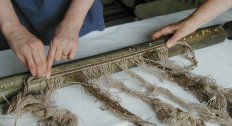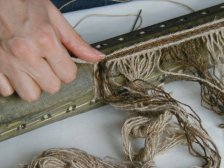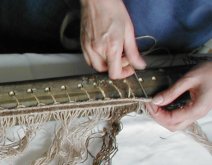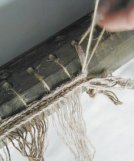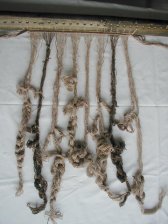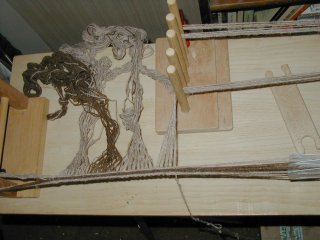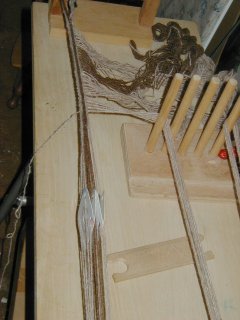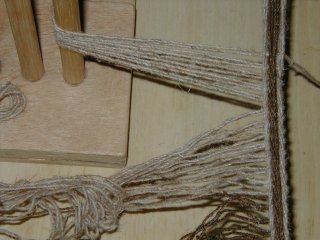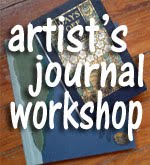Anne Dixon visited our guild this weekend – a very entertaining and informative talk yesterday which focussed on the history of inkle weaving, then a workshop today. One of the great things about going to follow-up workshops is that you get a chance to look at the tutor’s samples in much more detail than after the talk. Another is the chance to work alongside friends, swapping ideas and having fun though working hard. A bonus this time was that Anne is a friend too, through the Braid Society and through other workshops at which she was a fellow student.
Today we were given a choice of 2 warping plans. I chose what she calls Baltic-style pickup, a technique used all around the Baltic Sea – Scandinavia, Latvia and so on. I’d already pretty much decided to choose that one, but seeing her samples yesterday confirmed I’d made the right choice as I loved her Baltic designs.Â
 I warped up my Ashford mini-inkle loom last night using 3 colours of #8 pearl cotton. (The third colour was white - you can just see a line of it on each side separating the borders from the main pattern area.)
 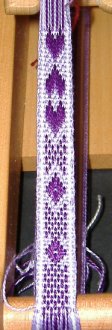
 Yes, that tiny sample is all I have to show from a 6-hour workshop, but I am still very pleased with it. I wove enough to convince myself that I now understand the technique, and that is what I needed to do today. I spent a lot of the time there watching Anne demonstrate other techniques on the other warping plan, but I couldn’t try any of those on this warp. I also spent a long time looking at her samples, and making notes of things I want to try later. Overall, a very enjoyable day!
We spent this past weekend at a Colour and Weave workshop with Janet Phillips at the Berkshire Guild. As usual, it was very enjoyable. Janet is an enthusiastic and inspiring tutor.
During Day 1, I ‘unvented’ a pattern which looked interesting on the loom, so instead of continuing with the worksheet, I spent some time weaving variations of it:
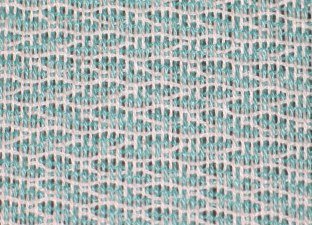
Janet wanted to see what it looked like once it was washed (so the threads would ‘bloom’ and move into their final positions), so that evening I cut it off the loom and retied the warp, then washed the sample, and wow, what a surprise!
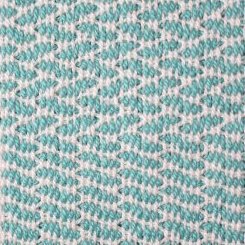
It amazes me how much fabrics change during the finishing process, even cotton. I really like this pattern, so I’ll probably continue experimenting with it using different yarns to emphasise the visual structure. First, though, I have to weave off the rest of this sample warp, and then I’ll probably put on another one to continue with my Colour and Weave experiments first as I’m really enjoying them.
I’ll let you in on a secret if you promise not to tell – I really wasn’t at all keen when it was decided that the workshop topic would be C&W and only went because I’ve enjoyed Janet’s previous workshops. I’m glad I did!
I mentioned in the May 24th entry that I had hoped to use that yarn for the Mulitcoloured Sockies in Socks, Socks, Socks but the colour spacing was too long. Instead, I spun up some undyed superwash merino top and handpainted it, and here are the Sockies I eventually made:
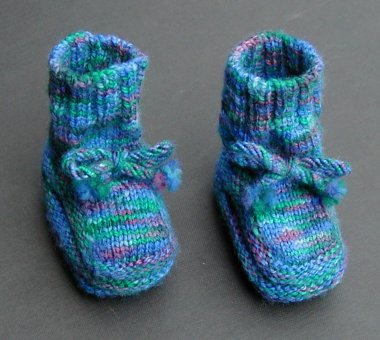
After many tries, we still haven’t managed to get the colours to show correctly. The actual sockies are darker, more saturated colours, but this picture does give some idea of the effect. I wanted the ‘dashes’ of each colour, just 4 or 5 stitches, and no pooling and that is what I got.
These sockies are fun to knit. I have a lot of the yarn left over, but not quite enough for another pair. I’m going to spin and dye a bit more yarn, maybe solid dye it in a colour from the yarn, then use it to knit parts of the sock – maybe just for the soles and cuffs and to make the cord.
I also want to spin some sock yarn for myself (maybe BFL/silk or BFL/nylon) and dye it in the same way and the same colours – watch this space but don’t hold your breath. :-)
One of my guilds, Kennet Valley, has been meeting in a church hall for many years. As a gesture of thanks, it was decided to make a tapestry for the church using as many of our crafts as possible. It took us a few years, but it was finally hung in the church last month.
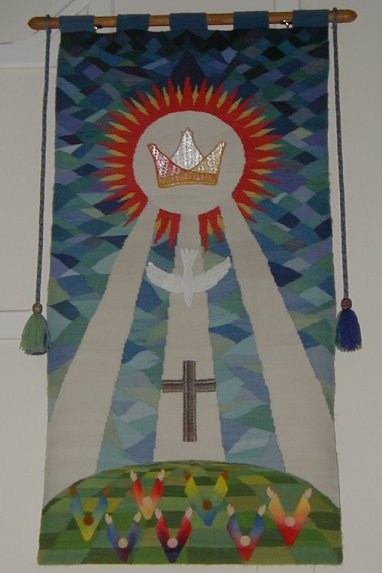
The main part of the tapestry is woven from Cotswold and other long wools spun by guild members (including me *grin*). The cross was inkle woven, the dove and the crown are bobbin lace (I’m not sure whether they were made with handspun thread) and so on.
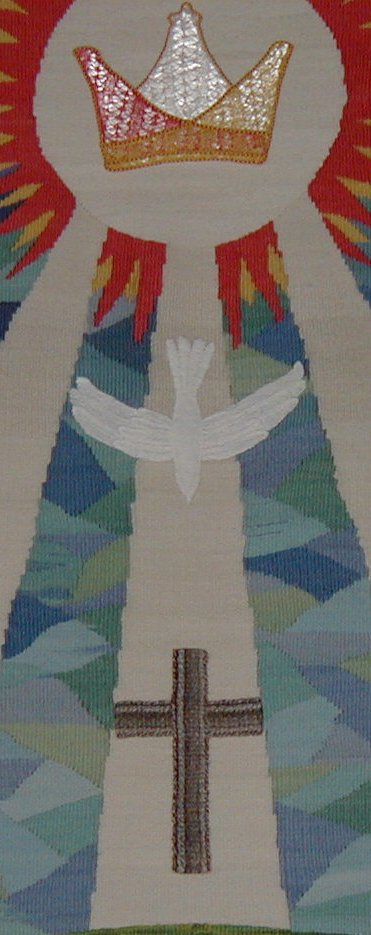
First, here’s a look at the silk scarf (or belt or hairband or however the recipient wants to use it) which I entered in the Berkshire Guild Challenge. The theme this year was “Nature’s Colour Palette”. We got the results at today’s meeting. Mine didn’t get a prize, but that’s fine by me as there were 15 entries, all of them very good, and I loved the prizewinners.

Technical details: warp – 16/2 silk dyed with acid dyes, weft – Gutermann’s sewing silk, plain weave. It was sett to make it very drapey, but I think it may have ended up too sleazy and unstable. The judge didn’t say that, though, so perhaps it isn’t too bad after all.
After the meeting, we took a friend home. While we were there we got some photos of the blue tit nestlings being raised in an old cylinder vacuum cleaner ouside her house. It seems that the hole where the hose went is just the right size for the adult tits.
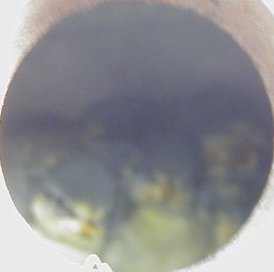
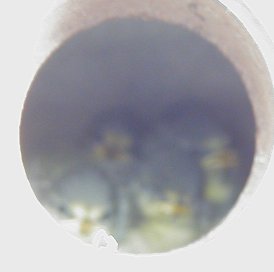
She keeps silkworms, and we had a look at her current ‘crop’. She doesn’t have any live moths at the moment, but she has some beautiful dead ones for display at demonstrations. She does have a lot of larvae at the moment, though. Moth-phobics are advised not to read on. :-)
Read the rest of this entry »
It’s been a while, but I can finally post pics of some of the things I’ve been doing this autumn. though others haven’t reached their recipients yet. I wove some bookmarks for an exchange, as I had a warp I needed to use up:
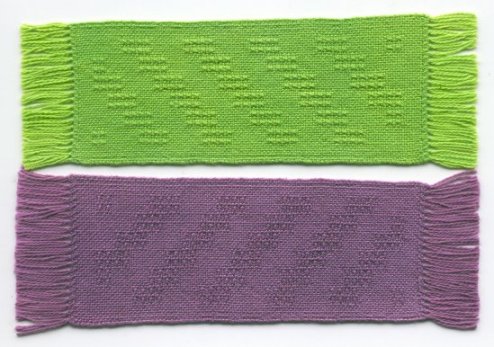

The warp and weft were 12/2 white mercerised cotton. I used fibre reactive dyes to dye the finished bookmarks. The dyeing wasn’t completely successful as too much of the dye washed out, changing the colours, so after those, I wove a few for Christmas presents using lilac 12/2 weft.
I went back to bobbin lace after a long break to make the rest of my exchange bookmarks, and I have really enjoyed that. I have done 3 so far, with one more to do, but I’ll make a couple more for presents.
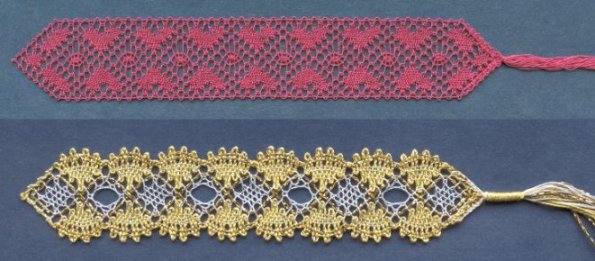

Tonight we got the band attached to the warp beam. Click on photos for close-ups, as usual. First, we had to work out where to position the band. Then we used the ends of the TW warp to tie it to the beam – under tension, so longer than 15″ again.
Next, I sewed it on, with Elizabeth’s help (Rys was also helping by being cameraman). We found it easier to sew it on without worrying too much about the tension, adjusting that at the end. In the next photo, as I am tying off the end of the sewing cord, it has already been tensioned and the stitches lie straight.
We discussed sewing along the band again but this time going all the way around the beam with each stitch, just for added security. Some of the attached warps shown in the Hoffmann book have this, others don’t. However it was getting late and we all wanted to eat, so we decided to leave it for this evening. Elizabeth will decide tomorrow whether to do the extra sewing. If she does want to do it, it should be easier to do alone than the first row of sewing would have been, as the band is already held in position.
While we were there, we took photos of the mockup WW loom which Elizabeth made at the start of this project to help us all understand the principle of WW looms. Small versions of those pictures don’t work, so click the description for the front view, back view and a close-up of the lovely stone weights. We would have like to use stone weights for the real loom, but we couldn’t get enough suitable ones, so we will be using bags of lead instead.
Well, that got your attention, didn’t it?
Actually, I don’t think we will be having an orgy on Saturday at the Open Day at Silchester, where the Roman town of Calleva Atrebatum is being excavated, but I hope it will be fun anyway. As I mentioned last week, the Berkshire Guild will be demonstrating Roman weaving and spinning, or at least doing our best to do so. We will be weaving on a warp-weighted (WW) loom, tabletweaving (TW), and spinning using spindles based on whorls found on the site.
I hope to get a chance to spin there, but my main involvement is with the tablet weaving. I’ll be demonstrating TW on the day (using ‘authentic’ wooden cards if I can finish them in time, plastic ones if not), but I have also been weaving the starting band for the WW loom warp. [If you aren't interested in the more technical details, skip to the pictures near the end.]
Later, WW loom warps were made over a cord which was attached to the top beam, but in the Iron Age and Roman times they were made by weaving a narrow band with a long fringe on one side which formed the WW warp. This serves to space the warp threads, which the later simple starting cords do not.
When I had read about these bands before, I had assumed that they would be woven with an ordinary weft and that the WW warp would be a supplementarty weft, but reading the ‘bible’ on WW looms, by Martha Hoffman, I found that the WW warp is the only weft used. The band warp grips the weft (= WW warp) well enough to stay in place while the warp is mounted on the loom (at least for wool, I don’t know how well it would work with silk).
Some of these bands are plain weave, but the majority seem to have a twisted structure which suggestes that they were made by tabletweaving. Some could possibly have been made by manual warp twining, but there are some wider borders for which this would have been very unlikely. A tabletwoven starting border with tablets still attached has been found in Spain in a 5th century BC grave, so we know the method was defintely in use well before Romano-British times.
I’ve been collaborating with Elizabeth, a very skilled tapestry weaver who has taken primary responsibility for the weaving, Janet who is producing the weights, and her friend Ken who has built the loom for us. Unfortunately, I don’t have photos of the loom yet, but I will be taking lots of pictures at the event and hope to have them here by Sunday (if I’m not exhausted), and there will be pictures on the guild site too.
My task was to produce the warp for the loom. We didn’t want to use a fine warp as that would make it harder for visitors to see what we are doing, so we decided on a well-twisted 2-ply wool yarn that will weave balanced plain weave at 8 ends (threads) per inch. Because of space restrictions our loom will only weave cloth about 24″ wide, but for this first attempt, our warp will only be 15-16″ wide.
The WW warp ‘fringe’ needs to be about 6 foot long and as consistent as possible. It is created by pulling loops of thread through the TW band, so I needed some way of measuring the length of those loops without having to keep walking across the room. The pictures below give an idea of how I set it up – as usual, click for a larger version.
Here is a better picture of the band and ‘fringe’ in progress.
I found it much easier to weave the band than I had expected. The biggest problem is that using the same yarn for the band and the WW warp and beating in the usual way for tabletweaving gives a warp spacing that is too close for plain weave. We had already decided that we didn’t want to weave twill as that would require multiple heddle rods (if you have no idea what a heddle rod is, later posts here or on the guild site should have a proper explanantion of the construction of the loom). I found just pressing the weft into position with my fingers once I had turned to the next shed was enough to give the right warp spacing. If we decide to weave twill for the second Open Day (yeah we might be that crazy!), I’ll probably need to beat that band in the usual way.
The next stage of warping will be to attach the band to the top beam. Elizabeth and I are meeting to do that tomorrow evening, so I may have a report (and pictures) on Friday.
backup, backup, backup …
… and the story of this moral is that my c: drive got corrupted last week and I lost all the data on it, and no, of course I hadn’t been good enough about keeping backups. I think I’m saddest about losing pictures of projects which I gave away or sent to exchanges over the past couple of years. I was better about things like my mail archive. Fortunately, some of the project pictures are here or on my web site, so I can retrieve those.
Anyway, if you have been reading this looking for fibre content, sorry, there isn’t any, except that our guild is involved in 2 Open Days at Silchester, a local Iron Age/Roman archaeological site, demonstrating Roman textile production. We are currently deep in the research stage. This evening, I’m going to inspect the progress in building our warp-weighted loom. I’ll write more about it over the next couple of weeks, or give an URL to the guild page on it when we get that done.
Meanwhile, here is another site about Calleva Atrebatum , as Roman Silchester was known.
Sometimes Tigs likes to hang around the table loom …. usually under it, but occasionally he gets higher ambitions.

A few minutes later, he was back in his usual position …
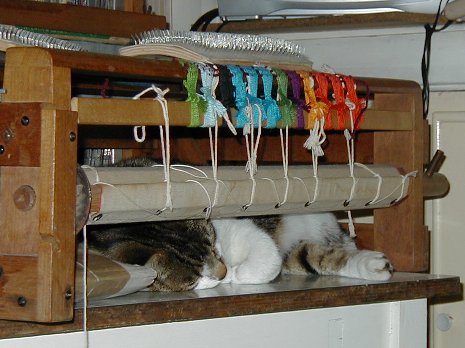
The carders are on top of the cloth to stop him lying there, BTW
I can’t resist a little bragging. The cushion got 2nd place out of 18 entries … :-)
